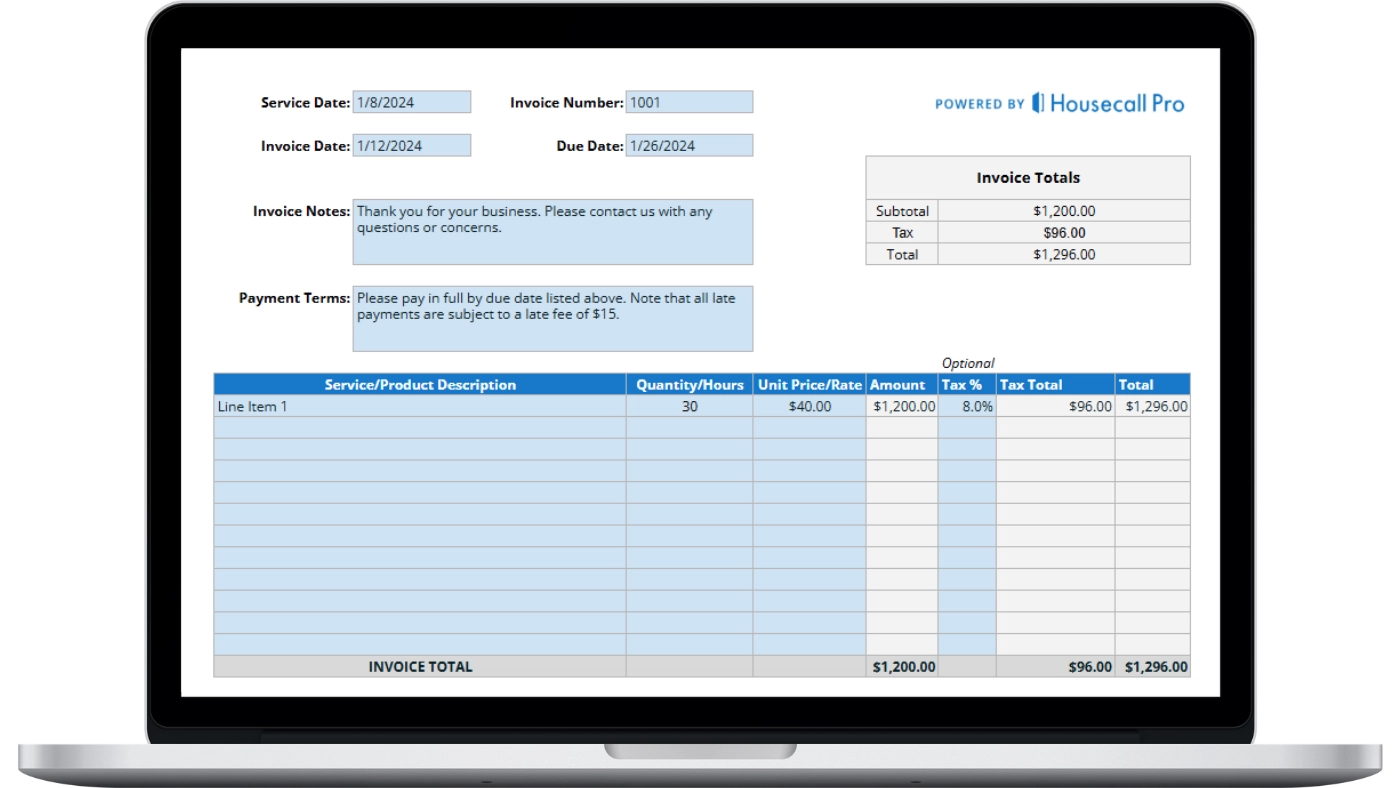Spending too much time on admin work?
Automate your daily tasks and save time with our home service software.
Want to win more jobs with less effort?
Grow your business and send quick quotes with our home service software.

Did you know that the typical homeowner will spend around $300 per month on various landscaping services for their property? So if you’re trying to grow your customer base, boost your revenue, and maximize your profits, knowing how to properly price your lawn mowing services can give you the leg up on your competition that you need in 2024.
With the new year fully underway, this guide is going to help you nail down how to price your lawn mowing services. We’ll go over key factors to consider when pricing your lawn mowing services, from material costs and overhead expenses to the unique needs of your local market. Whether you’re a seasoned pro or just starting, you’ll walk away with a clear understanding of how to price your services competitively and profitably.
How to Price Lawn Mowing Services
How Much to Charge for Mowing Lawns in 2024
The average rates in the United States typically range from around $30 to $60 per visit for different lawn mowing services among landscaping companies, depending on the size of the lawn being worked on, along with cost differences depending on the state and city that you’re in.
Lawn Mowing Services Pricing Chart
| Service Category | Price Range |
| Weekly Lawn Service | $65 – $100 |
| Monthly Lawn Service | $200 – $400 |
| Annual Lawn Service | $2,000 – $4,000 |
| Lawn Aeration | $75 – $204 for 10,000 sq. ft. |
| Lawn Seeding | $100 – $5,880 depending on size |
| Lawn Fertilization | Average $224, varies by lawn size |
| Leaf Removal | $190 – $540 |
| Spring/Fall Yard Cleanup | $100 – $250 |
| Lawn Winterization | $80 – $380 |
| Landscape Edging/ Curbing | $700 – $1,700 |
| Sprinkler System Installation | $1,700 – $3,400 |
| Tree Pruning/Trimming | $292 – $638 |
Note: These are the average prices for how much to charge for mowing lawns that are based on currently available national data, but we should note that they can vary based on location, lawn size, and specific service details.
Lawn Mowing Pricing Models
Lawn mowing companies often use a variety of pricing models to help them meet the diverse needs of potential customers.
Because of this, understanding the various nuances between them can help lawn care service providers better optimize their pricing strategy for maximum profitability, revenue, and customer satisfaction.
By the Hour
Charging by the hour is one of the most common pricing models in the lawn care industry today. It allows businesses to bill for the actual time spent on a job, making it easier to account for unforeseen delays or additional work.
Taking advantage of hourly rates for your pricing can help boost your profits, especially if you’re dealing with larger lawns or ones with more complicated topography and terrain that require extra time and effort to tackle.
However, there are a few key things that you’re going to want to keep in mind when determining your hourly rate. For example, when setting an hourly rate it’s important to factor in travel time, equipment preparation, and cleanup.
Also, relying solely on hourly pricing can sometimes make your services seem more expensive compared to competitors with lower-quality equipment but cheaper rates. Because of this, properly understanding how much to charge per hour for lawn mowing involves a delicate balance of ensuring profitability while remaining competitive in the market.
Per Square Foot
Another popular pricing model is charging according to the lawn’s square footage. This method offers greater pricing predictability since companies can establish a standard rate per square foot, making it straightforward for clients to understand and for businesses to forecast revenue.
However, this model’s simplicity might also be its downfall in certain scenarios. For instance, charging per square foot may not adequately account for additional challenges or special requirements of a particular lawn, such as high grass density or obstacles that slow down mowing.
It’s essential to determine how much to charge for lawn mowing per square foot or even how much to charge for lawn mowing per acre while considering these factors to keep your prices fair and profitable.
Flat Fee
Some lawn care companies out there may opt to use a flat fee model for their services where a single price is set for a specific service regardless of the lawn’s size or the time that’s spent on the task. This option can be extremely attractive for people who prefer clear and straightforward pricing, especially when considering how much it can simplify the billing process as a whole.
When trying to determine a flat fee for your services it’s important to accurately estimate how much work you can accomplish in a set amount of time while considering the variety of factors that could affect job duration. Understanding your operational costs and the average job time is key to setting a flat fee that covers expenses and ensures a profit margin.
While this method offers simplicity, it requires a good grasp of your service efficiency and market rates to avoid undercharging or overcharging for your services.
Get In Touch: 858-842-5746
Let us earn your trust
See plan options and feature breakdown on our pricing page.
What to Consider When Charging for Lawn Services
When it comes to charging for lawn mowing services, several important factors play into setting the right price. Understanding these components ensures that you’re achieving profitability while remaining competitive and achieving new levels of customer satisfaction.
Overhead Costs
Your landscaping business’s overhead costs refer to all of the necessary expenses that come with operating your business that aren’t directly linked with performing a specific lawn service.
So for example, these expenses can include things like the cost of office space, equipment costs and maintenance, insurance, fuel, and even marketing expenses if needed. On top of this, overhead costs can also encompass taxes and any other costs that are essential when it comes to maintaining your business.
To help you calculate your overhead costs, you’re going to first need to create a total of all of your monthly overhead expenses. After that, you’re going to want to divide this figure by the average number of jobs you take on in a month. This calculation will give you the overhead cost per job, which you should then directly factor into your pricing strategy to help ensure that you’re covering all of your expenses and generating a profit at the same time.
Material Costs
Material costs play a huge role in pricing lawn mowing jobs. This includes equipment costs, such as lawn mowers, trimmers, and other tools. The type of lawn mower you have can also impact your costs, with larger, more powerful models typically requiring more maintenance and fuel.
On top of your initial equipment costs, you’ll also need to factor in the ongoing costs of running your lawn-mowing business. This can include fuel, oil, and other consumables, as well as any additional costs associated with maintaining and repairing your equipment. These costs can quickly add up, so it’s important to account for them when determining your pricing.
This will help you set a fair and competitive price that covers your expenses and makes a reasonable profit. By being transparent about your material costs, you can build trust with your clients and demonstrate the value of your services.
Labor Costs
Labor costs represent a significant portion of the expenses in lawn care services. They can vary significantly based on the lawn’s size, topography, and overall condition, which can all affect how much time and effort are needed for a given service. Alongside this, the experience and efficiency of your lawn care team also influence these costs.
If you expand your business to include more employees, then you must consider the increased labor and associated overhead costs. Each new team member’s salary, benefits, and any additional training or equipment they require will impact your overall expenses and should be reflected in your pricing.
Profit Margins
Your profit margin is the percentage of the sale price that is your actual profit. To protect the financial health of your businesses, you’re going to need to understand how to calculate and aim for a healthy total profit margin. Figuring this out involves first determining the cost of providing your service (including direct costs and overhead) and then adding a healthy and reasonable markup to help you achieve your desired profit percentage.
To calculate the markup, you can use this lawn-mowing pricing formula:
Profit Margin = (Revenue – Operating Costs) / Revenue x 100
For example, if you make $5,000 in revenue in one month, and your total operating costs add up to $3,200, you can calculate your profit margin as:
Profit Margin = ($5,000 – $3,200) / $5,000 x 100 = 36%
So your profit margin for that month would be 36%, which is considered a very healthy profit margin for a lawn care business.
Location
The property’s location can notably influence the cost of lawn care services, and factors like the local economy, cost of living, and the area’s climate all play key roles in determining service prices.
Geographic and climatic factors also play an important role; for example, lawns in regions with heavy rainfall may require more frequent mowing, and local flora and fauna can affect the type and frequency of lawn care services needed.
Seasonality
The demand for professional lawn mowing services fluctuates with the seasons, which should be considered when setting prices.
Spring and summer usually bring higher demand, allowing for potentially higher rates due to the increased need for regular lawn care. In contrast, demand may wane in autumn and winter, possibly leading to adjusted pricing strategies to maintain steady business flow during these off-peak times.
Understanding these seasonal trends can help you better anticipate demand and adjust your pricing to maintain profitability year-round.
How to Price Lawn Mowing Services
If you’re running a lawn mowing business, you may be wondering how much to charge for commercial lawn mowing services. When pricing your lawn mowing services, try to employ a structured approach to help you set competitive and profitable rates.
Step 1: Choose a Pricing Model
Before setting your prices, decide on a pricing structure that complements your business approach. The three primary models employed in the industry are:
- Hourly Rates: Charging by the hour can be straightforward and ensures you’re compensated for the time spent on the job. This model is particularly effective for jobs where the scope is uncertain or varies significantly.
- Per Square Footage: Pricing based on the lawn’s area is common and provides clarity and predictability for both the service provider and the customer. It works well for mowing and is easy for customers to understand.
- Flat Rates: Offering a flat rate for a specific service package can simplify billing and marketing. It’s ideal for standard lawn care services where the required time and effort are relatively consistent.
Step 2: Scope Out the Lawn
Before quoting a price you’re going to want to make sure to assess the lawn in person or through a detailed series of pictures. During your assessment you should carefully evaluate the lawn’s size, the type of terrain your dealing with, the grass type, and its overall healthᅳalso, try to pinpoint any sections that may need some extra focus or more intensive effort for you or your team to take care of.
Taking the time to do so helps ensure that your pricing directly reflects the time, labor, and resources that are needed to get the job done to the client’s complete satisfaction.
Step 3: Consider Upselling Opportunities
While the primary service is lawn mowing, offering additional services can significantly boost your revenue per job. If you’re trying to boost your lawn business this year, consider these upsells:
- Edging and Trimming: These services provide a polished look, enhancing the overall aesthetic of the lawn.
- Mulching: Doing so helps retain soil moisture and reduce weed growth to offer both aesthetic and health benefits to the lawn.
- Fertilization and Weed Control: These services are essential for lawn health and appearance, these services are often sought after by homeowners.
- Seasonal Cleanups: These services help homeowners by addressing leaves, branches, and debris that can add value to your offerings, especially in autumn or after storms.
Step 4: Calculate Costs and Expenses
Take the time to determine your direct costs, including labor, fuel, equipment wear and tear, and materials. Oh, and don’t forget to factor in the overhead costs like insurance, marketing, and business licenses.
For additional services such as yard debris removal or reseeding, consider the cost of materials, extra time, and effort required. Your final price should cover these costs while also providing a healthy margin for profit.
Additional Lawn Mowing Factors To Consider
When setting your lawn mowing prices, it’s important for you to carefully consider several factors that go beyond just the size of the yard. These elements can influence the effort, time, and resources needed for each job, affecting your pricing structure and service efficiency.
Lawn Accessibility
The ease of access to a lawn can significantly impact the effort required for mowing. Factors like irregular shapes, sloped terrains, and the presence of obstacles such as trees, garden beds, or water features can make mowing more challenging and time-consuming.
Each of these complexities may necessitate additional labor and equipment, which in turn can potentially increase the cost of the service.
Grass Type
Different grass species have their own varying growth rates, ideal cutting heights, and maintenance needs. For example, Bermudagrass requires frequent mowing due to its rapid growth, while fine fescue grows more slowly and might not need to be cut as frequently.
Thoroughly grasping the unique requirements of differing grass species can help in scheduling and pricing the mowing services accurately.
Grass Length
Keeping grass at the right length is essential for keeping it healthy and looking good. It’s important to note that longer grass can take more time and effort to mow, potentially increasing mowing costs.
Regularly mowing at shorter intervals can make mowing easier and improve your lawn health by preventing the accumulation of excessive clippings that can smother the grass.
Lawn Health
Healthy lawns are so much easier for landscaping companies and homeowners to maintain. A variety of factors, including the amount of sunlight it gets, how often it’s watered, whether it’s fertilized or not, along with weeding and seeding methods, all play significant roles in a lawn’s overall health.
If a lawn is properly maintained then it’s going to need less corrective work over time to keep it looking at its very best, which can cut down on maintenance needs while keeping costs lower. With this in mind, take the time out to properly assess the health of the lawn that you’re working on to ensure you’re giving it the exact treatment it needs.
Mowing Frequency
How frequently a law particular lawn needs to be mowed really depends on the type of grass that you’re mowing, how fast it grows, and the current season that you’re in. Mowing a lawn regularly can save costs by keeping the lawn at a more manageable height, which can help reduce the amount of time and effort that needs to go into follow-up maintenance mows.
Sitting down and creating a mowing schedule with your clients can help keep their lawns looking at their very best during key seasons while making mowing much easier for you and your team.
Housecall Pro: Your Lawn Care Pricing Partner
As a lawn care business owner, trying to stay on top of and manage the many ups and downs that come with pricing your lawn care services can get tricky at times. Thankfully, this is exactly where a lawn care business software like Housecall Pro can help you determine profitable pricing on every lawn job.
- Flat Rate Pricing: You’ll never come up short on another lawn mowing job again. Housecall Pro’s Flat Rate Price Book powered by Profit Rhino helps lawn care businesses stay profitable. This feature provides pre-set pricing for common lawn care tasks.
- Seamless Estimating and Invoicing: Housecall Pro provides tools to help lawn care businesses manage the seasonal swings in their business. You can quickly transform your estimates into work orders and generate professional invoices that integrate seamlessly with QuickBooks.
- Job Profitability Tracking: Measure your growth and look at job profitability in real-time. This data can be invaluable for lawn care companies to analyze their costs and set competitive, profitable pricing.
- Recurring Service Plans: You can help stabilize your income stream throughout the year by taking advantage of recurring service plans. It’s a really helpful feature that lets landscaping companies easily create and manage their ongoing customer service agreements with a degree of unprecedented ease.
Trying to figure out the best pricing method and model for lawn care services isn’t always easy, but with Housecall Pro, you’ve got a solid partner to help you get it right.
Ready to experience the difference for yourself? Try Housecall Pro for free today and take the first step toward having a more profitable, efficient, and streamlined lawn care business.






